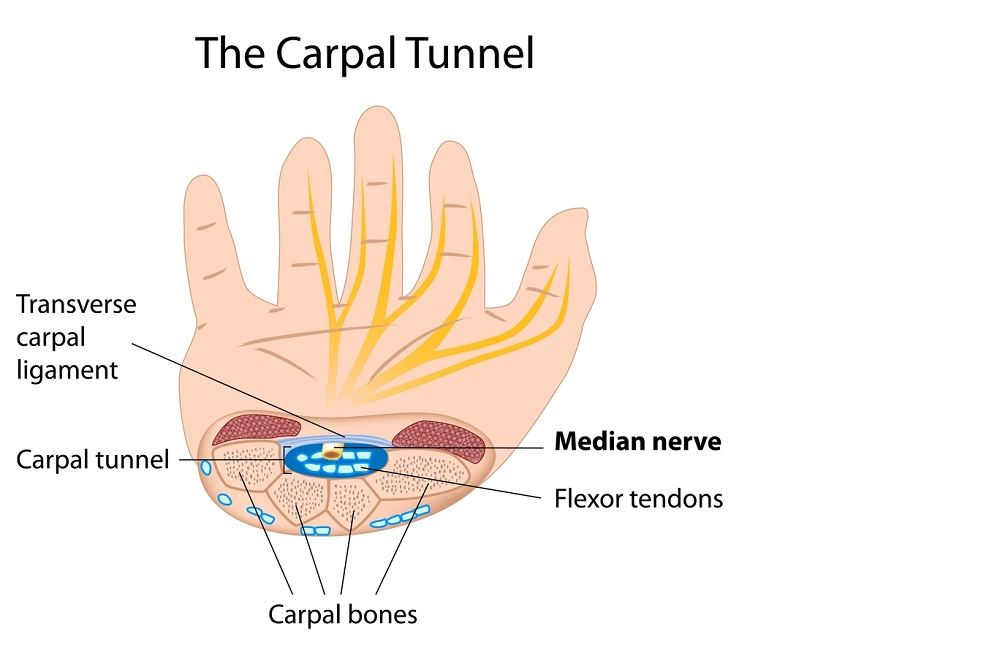 Have you ever felt a tingling sensation in your hands and arms that lingers for a while? Maybe you noticed numbness along with tingling, like your hand or arm was falling asleep? This could be a common wrist condition known as carpal tunnel syndrome. When a nerve in the wrist becomes pinched, it can cause an uncomfortable tingling and numbness in your wrist that extends into your hand and arm. People can develop carpal tunnel syndrome from everyday activities or from playing sports that require a lot of hand and wrist movements. Musicians, construction workers, and athletes can all develop carpal tunnel syndrome. It can take weeks or months for you to recognize the signs and symptoms of carpal tunnel pain. What may start out as mild wrist pain can get worse slowly and gradually. Here’s everything you need to know about carpal tunnel syndrome, including symptoms and treatment options.
Have you ever felt a tingling sensation in your hands and arms that lingers for a while? Maybe you noticed numbness along with tingling, like your hand or arm was falling asleep? This could be a common wrist condition known as carpal tunnel syndrome. When a nerve in the wrist becomes pinched, it can cause an uncomfortable tingling and numbness in your wrist that extends into your hand and arm. People can develop carpal tunnel syndrome from everyday activities or from playing sports that require a lot of hand and wrist movements. Musicians, construction workers, and athletes can all develop carpal tunnel syndrome. It can take weeks or months for you to recognize the signs and symptoms of carpal tunnel pain. What may start out as mild wrist pain can get worse slowly and gradually. Here’s everything you need to know about carpal tunnel syndrome, including symptoms and treatment options.
How the Carpal Tunnel Works
 The carpal tunnel refers to a narrow pathway inside the wrist that provides a passageway for the median nerve. The carpal tunnel gets its name for its tube-like shape and is supported by ligaments, tendons, and carpal bones. Your wrist joint has a lot of mobility so that you can bend and rotate your hand. The median nerve provides feeling and sensation to all the fingers in your hand except the pinky finger. The motor functioning of your thumb also depends on the median nerve. When something compresses or squeezes the carpal tunnel, it can aggravate the median nerve running through it. Repetitive motions of the hands, fingers, or wrists can put a lot of pressure on your wrist joint. The carpal tunnel may narrow, putting pressure on the median nerve. When the median nerve inside the carpal tunnel becomes aggravated or compressed, it may start to swell. This can cut off feelings and sensations to your hand and fingers.
The carpal tunnel refers to a narrow pathway inside the wrist that provides a passageway for the median nerve. The carpal tunnel gets its name for its tube-like shape and is supported by ligaments, tendons, and carpal bones. Your wrist joint has a lot of mobility so that you can bend and rotate your hand. The median nerve provides feeling and sensation to all the fingers in your hand except the pinky finger. The motor functioning of your thumb also depends on the median nerve. When something compresses or squeezes the carpal tunnel, it can aggravate the median nerve running through it. Repetitive motions of the hands, fingers, or wrists can put a lot of pressure on your wrist joint. The carpal tunnel may narrow, putting pressure on the median nerve. When the median nerve inside the carpal tunnel becomes aggravated or compressed, it may start to swell. This can cut off feelings and sensations to your hand and fingers.
Signs & Symptoms of Carpal Tunnel Syndrome
Signs and symptoms of carpal tunnel syndrome will typically appear gradually. The first thing you may notice is numbness in your hand and wrist when you wake up in the morning. You may find yourself shaking your hands gently to resolve the numb sensation. Carpal tunnel syndrome can also cause pain and tingling, like a pins and needles sensation. You may feel like your hand or wrist has “fallen asleep,” and this might start to happen more frequently. Carpal tunnel syndrome can also cause decreased sensation in your fingers, and you may start to have more difficulty with fine motor skills, like grasping an object, writing, or using a keyboard. As carpal tunnel syndrome becomes worse, symptoms may start to occur more frequently or even constantly. If you start to notice pain, tingling, and numbness in your fingers, hand, and wrist, then talk to your doctor as soon as possible. It helps to catch carpal tunnel syndrome early to avoid more severe symptoms like hand weakness, reduced mobility, and muscle atrophy.
Nonsurgical Treatment Options for Carpal Tunnel Syndrome
 In many cases, your doctor will typically recommend a more conservative approach to treatment at first. NonsurgicalNonsurgical treatment options range from noninvasive to minimally invasive techniques to help relieve your pain and reduce compression of the median nerve. Before resorting to carpal tunnel surgery, here are examples of nonsurgical treatment options to try.
In many cases, your doctor will typically recommend a more conservative approach to treatment at first. NonsurgicalNonsurgical treatment options range from noninvasive to minimally invasive techniques to help relieve your pain and reduce compression of the median nerve. Before resorting to carpal tunnel surgery, here are examples of nonsurgical treatment options to try.
Home Remedies
In mild cases of carpal tunnel syndrome, you may be able to manage pain, inflammation, and swelling at home. These home remedies for carpal tunnel may include over-the-counter medications for pain and inflammation. If you notice repetitive activities like playing piano, working with a hand drill, or typing at your computer make your symptoms worse, then schedule breaks from these tasks and give yourself a chance to stretch and move your hands and wrists. Taking breaks between activities that aggravate the median nerve in your wrist will allow time for swelling and inflammation to go down naturally. Applying ice to your wrist when it becomes painful can also help reduce swelling and inflammation.
Wrist Splints
Your doctor may recommend a splint to help keep your wrist straight while you sleep at night or when performing certain repetitive tasks. A splint on your wrist can help reduce symptoms of carpal tunnel syndrome by relieving the pressure on your median nerve. A wrist splint can also give the muscles and tendons in your hand and wrist a break from holding tension while swelling and inflammation go down. A wrist splint or brace will help provide you with pain relief and also prevent further aggravation of the area.
Lighten Activities
You may notice that you strain or force certain movements, which puts added pressure on your hand and wrist. Some people develop carpal tunnel syndrome from using too firm of a grip while performing activities like writing or typing. Practice relaxing your grip and reducing the amount of force you use during the activity. In order to maintain healthy dexterity in your hand and wrist, you want to pay attention to how much pressure and strain you put on them during everyday tasks and activities.
Chiropractic Care
Chiropractors offer an all-natural approach to pain relief and treating a wide range of conditions, including carpal tunnel syndrome. Chiropractic care can help alleviate symptoms of carpal tunnel syndrome by resolving misalignments in your wrist joint that may be making your symptoms worse. Chiropractors use hands-on approaches to promote healing and healthy functioning in the area. A chiropractor will identify what is putting pressure on your nerves and develop a treatment plan to reduce inflammation in the area. Soft tissue mobilization and massage therapy can also help with relaxing and lengthening muscles that support your affected wrist.
Physical Therapy
If you are dealing with wrist pain from carpal tunnel syndrome, then a physical therapist can help. Physical therapy will provide you with an active approach to treatment where you can engage in stretches and exercises to promote healing. When you visit a physical therapist for carpal tunnel syndrome, they will work with you to improve strength, flexibility, and mobility in your hand and wrist. A physical therapist will develop a personalized therapeutic exercise program to address your carpal tunnel symptoms and help reduce pressure on the median nerve.
When Carpal Tunnel Surgery Is Necessary
In some cases, your doctor may recommend carpal tunnel surgery as your best option for long-term relief. Over time, your hand and wrist muscles can weaken due to carpal tunnel syndrome. When other treatment options like home remedies, wrist braces, and changes to your activities have not been enough to reduce your pain and other symptoms, then carpal tunnel release surgery may be your next option. Symptoms of carpal tunnel syndrome that last for longer than 6 months with little to no lasting relief from nonsurgical treatment options may require surgical treatments. There are two main types of surgery for carpal tunnel syndrome: open surgery and endoscopic surgery. With open surgery, a surgeon will create an incision from your wrist to your palm and trim the ligament around the carpal tunnel to help reduce pressure on the median nerve. Endoscopic surgery involves a smaller opening in the wrist or arm, and the surgeon uses a tiny camera inside to guide the procedure. Your doctor may recommend endoscopic surgery for carpal tunnel because the healing time is faster, and the recovery process is less painful. For most mild and moderate cases of carpal tunnel syndrome, surgery can fix symptoms like pain, tingling, and numbness permanently.
Long-Term Effects of Carpal Tunnel Surgery
A mild or moderate case of carpal tunnel syndrome will typically respond well to surgery, even if nonsurgical treatment approaches have been less than successful. During carpal tunnel surgery, the ligament around the carpal tunnel is cut, which provides more space for the carpal tunnel and reduces pressure on the median nerve. As you heal after surgery, the ligament will also grow back together, but this time it will leave more room for the carpal tunnel and median nerve to pass through unrestricted. Delaying carpal tunnel surgery can lead to symptoms gradually worsening and even causing permanent nerve damage. Long-term results of carpal tunnel release surgery can vary depending on how long you have had symptoms and their severity. However, many people who undergo carpal tunnel surgery regain hand function and experience less or no pain after healing. Carpal tunnel surgery is a highly effective procedure that requires less downtime than you may think.
If you are dealing with carpal tunnel pain that doesn’t seem to go away, then talk to one of our doctors at AICA Orthopedics about your options. With multiple locations throughout the metro Atlanta area, AICA Orthopedics has a team of doctors available to provide you with a wide range of treatment options that will work best for you. Our team of doctors includes orthopedic surgeons, chiropractors, neurologists, and physical therapists who work together to provide you with quality, comprehensive treatment and care. Visit AICA Orthopedics in Atlanta to learn more about your options for treatment, including whether carpal tunnel surgery is right for you.
